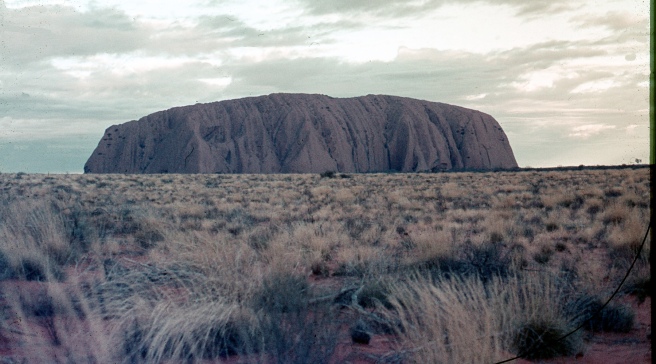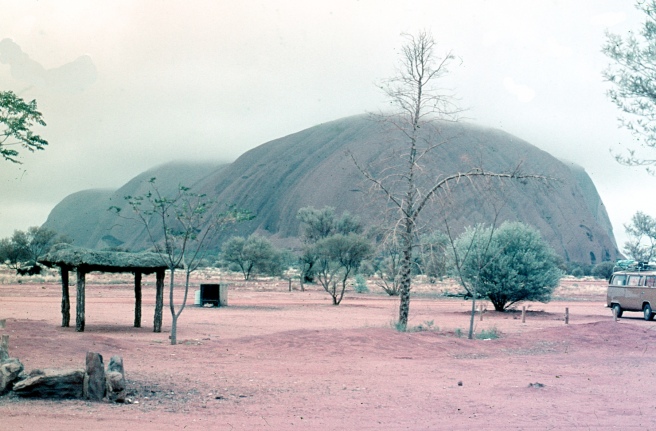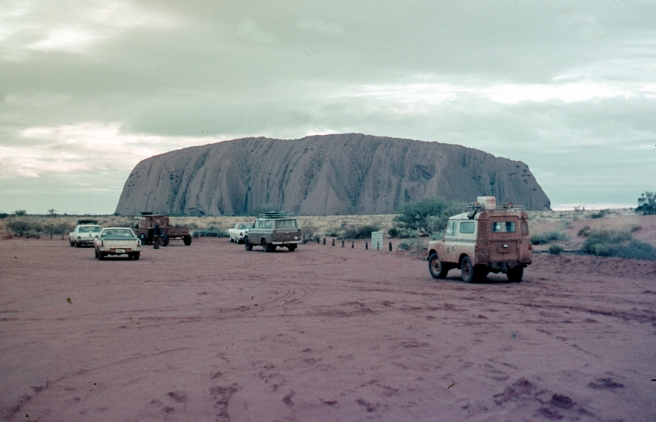In drizzling rain we left Henbury en route to Ayres Rock and The Olgas. I know I should call the The Rock correctly as Uluru but old habits die hard. After all, I first visited Ayres Rock in 1962 in my little Simca Aronde. I’ve no trace of the photos I took way back then but I remember that it was even less developed way back then.
We were disappointed that our Henbury meteorite hunt had been aborted but on the positive side we got out of Crater 6 without too much trouble and with no losses.
The closer we got to The Rock the more it rained and the soggier became the track. Fortunately I’d put new off road tyres on the Landy before leaving home and they were handling the wet conditions without fuss.
It’s the fortunate few who are able to see the impact of rain on the arid parts of the Territory and on this part of our adventure we were indeed fortunate as we passed this expanse of water on our way out from Henbury.

Not long after, in the distance we caught our first view of Mt Conner. This massive mesa is often mistaken by first time visitors as The Rock itself . There are a number of tracks that take you across to Mt Conner but as our time was running short we had to resist the urge to explore the mesa up close.

Similarly to The Rock the changing light causes colours of Mt Conner to alter. Here is another view as we got closer and the light was changing.
Where we stopped to make this last image of Mt Conner I noticed a Bull Ant’s nest with it’s built up water proofing mound. The old bushies and the Aboriginal people can tell when big rain is coming when they see the Bull Ants creating their little walls. I put the match box along side the nest to give an indication height.

Finally Ayres Rock with a distant view of the Olgas came into view. For once I made a note of the odometer reading and when I checked when were actually there, it was just over 9 miles from The Rock when I made the photo.
Back then the road into The Rock was just dirt and fitted into the landscape with no significant impact. It was well compacted dirt too and a pleasure to drive on, just as it was when I visited in 1962 in my little Simca.

A few isolated puddles on the road were an indication of the amount of rain that preceded our arrival.

Getting closer, the enormous size of this spectacular monolith becomes more apparent.

Finally we reached a vast cleared area near The Rock which now was covered by either low cloud or mist. It was an amazing sight.

Closer still the light had changed again and the mist was beginning to lift revealing some of The Rocks features.


After boiling the billy we decided to take a drive around The Rock and look for a spot to set up camp. Were we in for some surprises as we came upon streams of water gushing down the sides of The Rock.



After circling the monolith we returned to the main observation car park and joined a crowd of five other vehicles with no people to be seen anywhere.

Later in the afternoon we moved around to a deserted spot and set up our camp early in order that we were organised to walk right around the Rock the next day.
Seeing the water cascading down the rock faces was an inspirational experience and I recognised the place as a genuine Sacred Site. I could feel the power and sense the mystery that was present.
In a strange way I was pleased that John never mentioned if he felt any personal impact from what we were observing.
Another plus was the total absence of any elements of bureaucracy, no commercial activity of note and all the visitors we encountered during our stay were responsible adults. How different it is there today.
Hoo roo for now.

